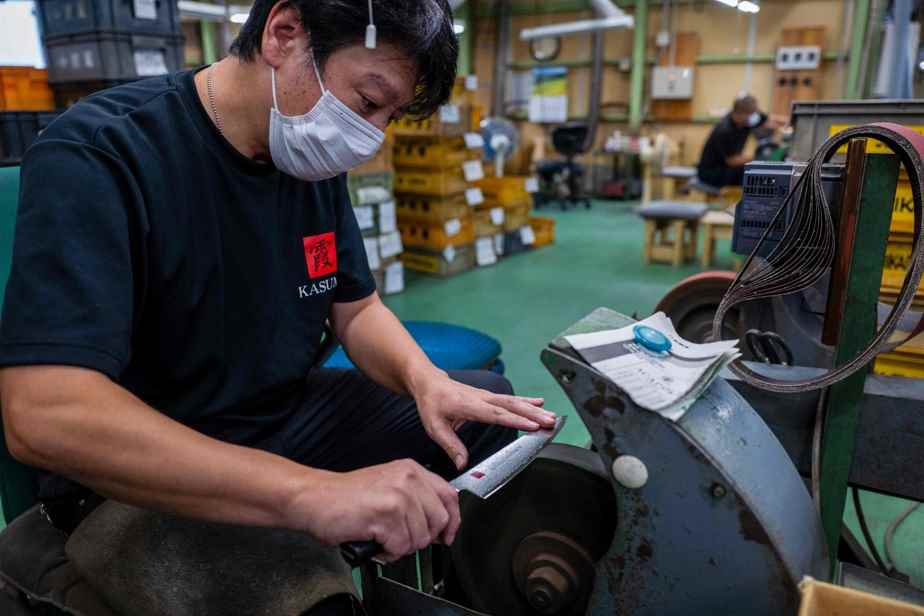(Seki) In a small Japanese town once famous for its samurai swords, craftsmen sharpen and polish kitchen knives. However, they are struggling to meet the global demand that has exploded since the pandemic.
Exports of these high-end Japanese tools reached a record 12 billion yen in 2021 (around 90 million euros), twice as much as twenty years ago, according to Japanese customs.
And these exports jumped 33% compared to 2020 against the backdrop of the home cooking boom with the COVID-19 pandemic.
But for years now, Japanese blades have been prized by food professionals around the world for their precision, elegant finish and durability.
Katsumi Sumikama, owner of the Sumikama cutlery in Seki, near Nagoya (central Japan), attributes this success to a “marriage between technology and traditional craftsmanship”.

PHOTO BY KAZUHIRO NOGI, AGENCE FRANCE-PRESSE
Customers visit Kama-Asa Cutlery Shop on Tokyo’s famous Kappabashi Street.
To obtain an exceptional cutting edge to perfectly make sushi or cut thin strips of wagyu beef, his company uses machines with a precision of one micron, or one thousandth of a millimeter, then the finish is done by hand.
But even operating at full capacity, “we are unable to meet the high demand,” Mr. Sumikama told AFP.
The luxury bet
The reputation of Seki blades dates back to the 14th century. The cleanliness of the rivers and the surrounding raw materials “were ideal for forging swords” of high quality iron from ferruginous sand, recalls the business manager.
This activity declined with the disappearance of the samurai at the end of the 19th century. But after World War II, Seki started producing pocket knives for export.
This trade initially took off, but the crisis hit again in the 1970s, notably with the appearance of Chinese competition at unbeatable prices.
Seki craftsmen then turned to high-end knives. At the time, German brands like Zwilling dominated this market segment, and luxury Japanese products were rare.
The Sumikama company started in the 1990s in the production of knives that can cost the equivalent of several hundred euros each.
To emphasize its “made in Japan” style, the company has added a wavelike visual effect to its knives, evoking the appearance of the blades of “katana” (traditional swords) and a Japanese character (kanji) as its logo.
But initially, skepticism about this move upmarket was significant. “We were stuck in the idea” that Japanese knives “would not be accepted by consumers unless they were cheaper than German products,” says Sumikama.
The strategy paid off: his company now has sales in more than 50 countries.
More than a kitchen tool
French chef Olivier Oddos has been a fan of Japanese kitchen knives for over twenty years. Their reputation has “really gone around the world,” he said in an interview with AFP in his restaurant “Chez Olivier” in Tokyo.

PHOTO BY KAZUHIRO NOGI, AGENCE FRANCE-PRESSE
French chef Olivier Oddos cleans a knife with a whetstone in the kitchen of his restaurant in Tokyo.
I know a lot of French chefs who have come to Japan, each time they buy Japanese knives. They even buy some for their whole team.
French chef Olivier Oddos
“It cuts perfectly, it cuts straight, it’s regular”, he boasts, believing that such precise cuts, “it changes the quality of the kitchen”.
The downside of Japanese knives, according to Mr. Oddos, is that you have to “maintain them very regularly” by sharpening them with a stone. But “if they are maintained well, they have a fairly exceptional lifespan”.
On Tokyo’s Kappabashi Street, famous for its kitchenware shops, shopkeeper Daisuke Kumazawa confirms that Japanese knives have been gaining popularity overseas for a decade.
He sees a direct link to the global craze for Japanese cuisine. His century-old “Kama-Asa” store even opened a branch in Paris in 2018, and success is evident in both stores, according to Mr. Kumazawa.
He wants his customers to see Japanese knives as much more than just a kitchen utensil. “We want them to know why they are good – the spirit of the knife, the idea of the craftsman who made it”.
